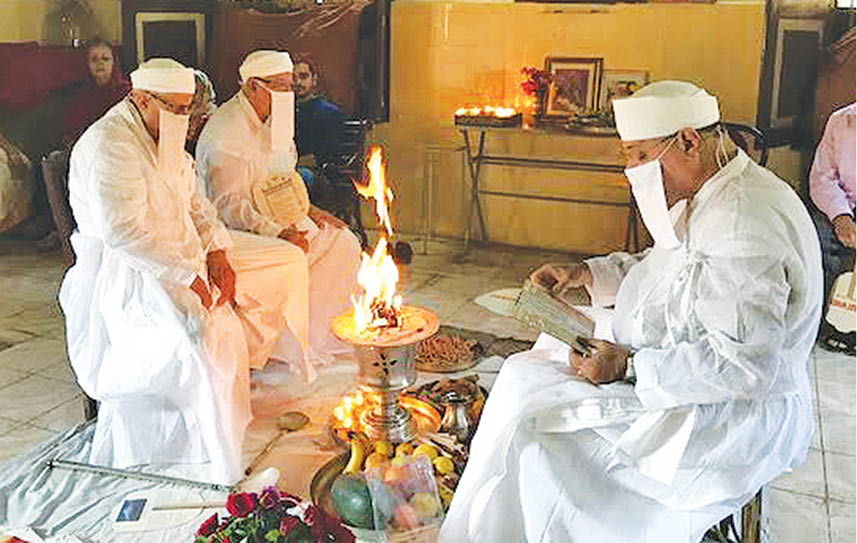During the month of Dae, Parsis perform Jasan ceremonies by way of thanks-giving at home, at their workplace as also at various community centers and places of worship. Colloquially or in ordinary conversation, Jasan means ‘rejoicing’ or an ‘assembly of rejoicing’. This is because the religious ceremony is usually followed by feasting and merriment among members of the family or the community. However Jasan is a Pahlavi or Middle Persian word for the Avestan word Yasna which means ‘act of worship’.
The Jasan ceremony is an outer liturgical ceremony, which means a ceremony that can be performed at any clean place, unlike inner liturgical ceremonies which can only be performed at an Agiary or Atash Behram in a specially consecrated area. Several auspicious days and occasions are celebrated by performing the Jasan ceremony. For example, the monthly parabh or the day when the Amesha Spenta or Yazata of the day is the same as the month (i.e. Roj Ardibehesht Mah Ardibehesht or Roj Adar Mah Adar). Incidentally, the term parabh is derived from the Gujarati word parva which means festival.
Jasan ceremonies are also performed to celebrate the six Gahambars and to offer gratitude to Ahura Mazda for His six good creations, namely: the sky, water, earth, vegetation, animals and human beings. There is also the Jasan of Sadeh to celebrate the discovery of fire and Jasan that is performed on Zarthosht no diso or the day when Zarathushtra departed from this world. Jasan ceremonies are also performed in memory/honour of the fravashi of our dear departed.
On happy occasions such as birthdays or weddings Parsis perform the Fareshta ceremony which is also a form of Jasan in honour of the Fareshtas or divinities. The Afringan is an important part of the Jasan ceremony which is performed by one priest called the Zaotar or Zot, meaning an ‘offerer’, who acts as the chief officiating priest, or, by a pair of priests, the Zot and his assistant, the Raspi. When three or more priests participate in an Afringan ceremony, it is called a Jasan, which then signifies an assembly of priests.
The Zot usually faces east while performing the Afringan ceremony, but he may face any other direction except north. The Jasan tray is usually filled with a variety of seasonal fruits and pomegranate which is very essential. There is also a metal vase or Karasyo filled with fresh water, a glass of milk along with a glass of wine or rose-syrup, variety of flowers and a fire vase or Afarganyu.
There is deep symbolic significance behind these essentials laid out at the Jasan ceremony. In fact, all the Seven Amesha Spenta or Divinities are represented. Ahura Mazda, the foremost Amesha Spenta is represented by the priest. Bahman is represented by the milk in the glass. Ardibehesht is represented by the ritual fire that is lit for the Jasan. Shehrevar is represented by the metal vase and Aspandarmad by the clean ground over which the Jasan ceremony is performed. Finally Khordad is represented by the fresh water and Amardad by the fresh flowers and fruits.
The Amesha Spentas represent at one level a Divine quality of Ahura Mazda and at another the guardian of a good creation. For example, Bahaman is Vohu Mana or the Good Mind and also a guardian of animals. Ardibehest is Asha Vahishta or Truth and presides over Fire.
Let us look at the chart below:
Hormuzd = Good Spirit (protector of humanbeings)
Bahman = Good Mind (guardian of bovine animals)
Ardibehest = Best Truth (presides over fire)
Sherevar = Divine Power (presides over metals and minerals)
Spendarmad = Piety / humility (presides over earth)
Khordad = Perfection (presides over the waters)
Amardad = Forever / eternal (presides over vegetation)
The Amesha Spenta teach us how we may lead our life.
- Begin and dedicate all work to Hormuzd or God;
- Do all work using Bahman or the Good Mind;
- Do it with Ardibehest or Truth;
- And you will attain Sherevar or Power;
- To power you must add Spendarmad or Piety and Humility;
- And you will get Khordad or Perfection;
- Which will last for Amardad or for eternity!
The Jasan ceremony proper is always preceded by the priests performing the Padyab-kushti (washing the hands, feet and face and untying and tying the sacred kushti around the waist. This is followed by the obligatory or farziyat prayers and recital of the Atash Niyaish or litany to the fire. Fire is the dispeller of darkness and giver of life as also a purifying and healing force. Hence, by reciting the litany to fire, the priest invokes blessings for a long and healthy life filled with warmth and light. The priest then recites the Pazand Dua Nam Setayesh in praise of Ahura Mazda. After this the priests exchange a ritual hand-clasp with the words: “hama-zor hama-asho bed” or “May we be united in spiritual strength, may we all be righteous in our actions.”
Eight flowers are also ceremonially arranged in the ritual tray and picked up one by one while reciting eight Yatha Ahu Vairyo in honour the righteous fravashis which are invoked and invited to bless the ceremony. Flowers also represent Amardad or the spirit of immortality.
The Jasan ceremony is concluded with reciting the Tandorosti praying for the good health and prosperity of all those assembled.
Jasan is essentially a ritual form of expressing gratitude and invoking Divine Blessings. When performed with faith and understand it can foster strong bonds of family and community and lead to peace, unity, good health and prosperity for all.
- Lessons Of History – Darius III And The Fall Of The Achaemenid Empire - 3 May2025
- The Sacred Ash Of Reinforcement, Resilience And Renewal - 26 April2025
- Birthday Of The Hearth Fire - 19 April2025
